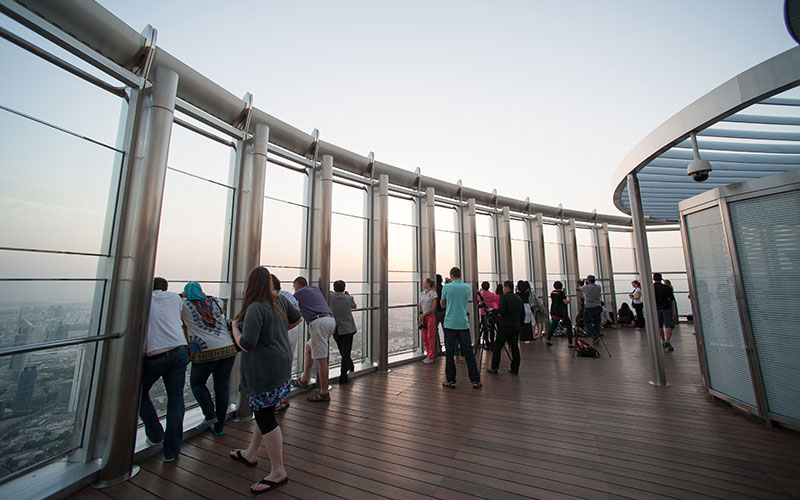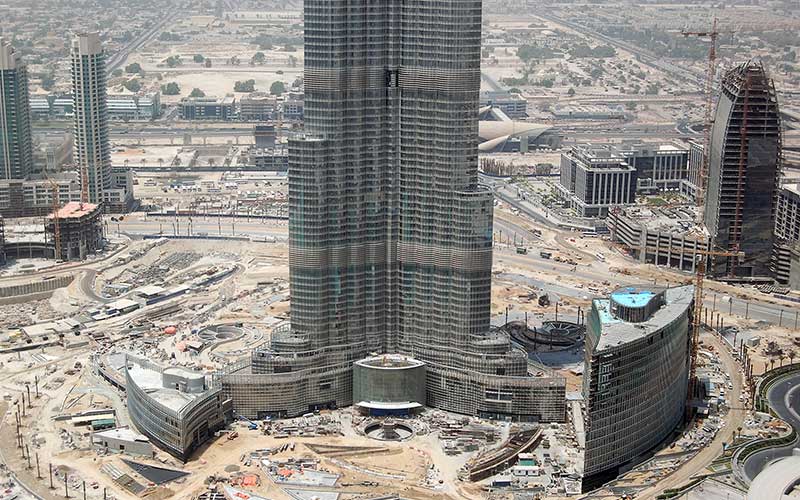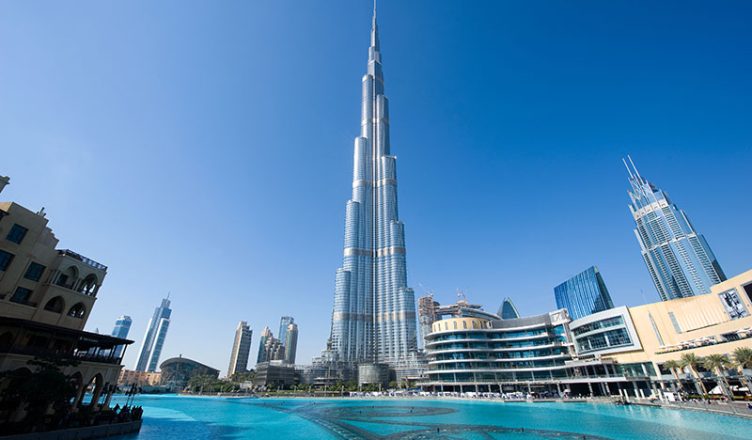The first impression you get when you look at Burj Khalifa is impressive! As with its exterior, Burj Khalifa is an architectural marvel on the inside as well. To learn more about it, let’s quickly explore the floors and interior of Burj Khalifa.
Quick Journey through Burj Khalifa’s Floors and Interior
Stepping Inside Burj Khalifa
Entering the Burj Khalifa, you can’t help but be awe-struck by the sleekly modern lobby decked out in stylish furnishings with accents of polished metal and colorful glass fixtures. Front desk attendants in crisp uniforms stand ready to check in visitors to the Armani Hotel or assist in accessing observation decks. Sparkling lighting bounces off the shiny stone floors, evoking a glitzy vibe befitting Dubai’s penchant for over-the-top luxury.
High-speed elevators whisk guests to the upper floors at 22 mph while providing jaw-dropping views of the Dubai skyline as it recedes below. It’s the world’s fastest elevator, adding to the building’s lengthy list of record-breaking attributes. Let’s explore the floors of Burj Khalifa in detail and discover what is inside Burj Khalifa.
Lower Floors: Armani Hotel (Floors 1-16)
The lower floors, from ground level to floor 16, house the Armani Hotel. Floors 1 to 8 have hotel rooms and suites, some with balconies offering sweeping views of Dubai. Floor 9 houses a swimming pool and spa for hotel guests. Floors 10 to 12 contain meeting rooms and business facilities. Floors 13 to 16 have private club lounges and restaurants exclusively for Armani hotel guests.
Residential Apartments (Floors 45-108)
Levels 45 through 108 contain 900 private residential apartments of various sizes. Key amenities for residents include swimming pools, gyms, gardens, and sky lobbies on floors 43, 76, and 123. These sky lobbies allow residents to switch elevators to reach their apartments faster. The two basements underneath the building contain a large parking facility for residents and guests.Living inside the world’s tallest building is truly extraordinary.
Corporate and Boutique Offices (Floors 109-154)
In the upper third of the building, floors 109 through 154 contain corporate offices and boutique offices that businesses can lease. One of the most interesting facts about Burj Khalifa is that you must spend $15 million per year to lease one floor of corporate office space.
Observation Decks and Restaurant (Floors 148-154)

The very top floors of Burj Khalifa hold two major tourist attractions. You will need to buy Burj Khalifa tickets to access these floors. Levels 148 through 154 contain the indoor and outdoor observation decks called At the Top Burj Khalifa Sky. Tourists can gaze at Dubai from floor 148’s outdoor terrace at 555 meters or visit the highest occupied floor in the world on level 154 at a dizzying height of 585 meters. One floor below the observation decks is level 147, which houses the world’s highest restaurant, At.Mosphere. The luxury dining spot offers a special experience at 442 meters above ground.
Owner of the Burj Khalifa
The Burj Khalifa is owned by Emaar Properties PJSC. It is a leading real estate development company in the UAE. Emaar envisioned the tower as the centerpiece of a large mixed-use development known as Downtown Dubai. The company wanted an iconic structure to put Dubai on the global map and drive further development. They contracted architect Adrian Smith and structural engineer William Baker to design the towering skyscraper. Construction began in 2004 by Samsung C&T from South Korea and opened in 2010.
History of the Name of the Burj
The building was originally named Burj Dubai. However, it was unexpectedly renamed Burj Khalifa during its opening ceremony. Abu Dhabi provided significant financial support for Dubai amid the global financial crisis in 2009. As a result, the building was named after the ruler of Abu Dhabi. Renaming the building of Burj Khalifa was seen as a gesture of gratitude. “Khalifa” translates to “the one who takes the place of” or successor in Arabic, befitting Sheikh Khalifa’s role.
Inspiration Behind the Design

The design of the 162-story Burj Khalifa draws inspiration from traditional Islamic architecture. The Y-shaped floor plan is inspired by the shape of the Hymenocallis flower. The three wings allow maximum outdoor views and natural lighting. The central core anchors the wings with minimal structural steel. Architect Adrian Smith has said the design resembles growing plant life, with wings spiraling skyward. The slanted exterior pays homage to the spiral minarets prominent in Middle Eastern Islamic architecture. The design successfully blends cultural inspiration with modern techniques and materials.
World Records of Burj Khalifa
The Burj Khalifa has broken numerous world records since its completion. It holds the records for tallest building, tallest free-standing structure, highest occupied floor, highest outdoor observation deck, elevator with the longest travel distance, and tallest service elevator. Some astounding stats about the building include:
- 162 floors above ground
- 57 elevators and eight escalators
- 304 hotel rooms across floors 45 through 108
- 900+ underground parking spaces
12,000+ people flow through the tower every day. Clearly, the Burj Khalifa has made its mark on history by shattering key building records.
Facilities
The Burj Khalifa houses a wide array of facilities to support its operations as the centerpiece of Downtown Dubai. Let’s look inside at some of the key offerings within this record-breaking structure.
At its base is the Dubai Mall, anchored by luxury shops, restaurants, entertainment venues, and an aquarium. Four heated swimming pools are located in the residential Armani Hotel. Floors 19-108 contain various corporate suites and office space. Guests can take in panoramic views from two observation decks on floors 124 and 148.
Those staying in luxury suites can access fine dining or step out onto their room’s balcony for unmatched views. The corporate offices occupy the numerous floors that make up the three wings. Key amenities for corporate tenants include meeting rooms, lounges, fitness centers, and cafes on designated hospitality levels. The Burj even offers luxury banquet halls and event spaces spread across five halls and various lounge areas. From shopping and dining to corporate offices and luxury stays, the Burj Khalifa delivers one-of-a-kind options showcasing innovation soaring high into the Dubai skyline.
The Burj Khalifa parking is of a multi-level situated at the base. It offers convenient access for tenants and visitors alike. This facility has been specially designed for accommodating end number of vehicles, considering the soaring volume of guests and tourists that visit the iconic landmark.
Final Words
The Burj Khalifa exemplifies and inspires its home base of Dubai to continue redefining possibility with each successive generation. As Dubai demonstrated resilience in fulfilling this gravity-defying structure in the wake of the crisis, so too shall emerging challenges yield ever-higher pinnacles in the future. As attention is drawn continually upward along the sleek glass exterior, the Burj Khalifa reminds us that the only true limits are those imposed in our minds.
Frequently Asked Questions
Q1.Why is the Burj Khalifa so tall? What was the motivation behind its record-breaking height?
Q2. How many people visit the Burj Khalifa's observation decks each year? What can visitors expect to experience?
Q3.What functions and facilities are housed within the enormous Burj Khalifa?
